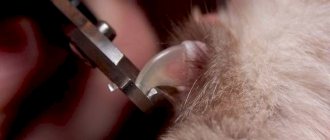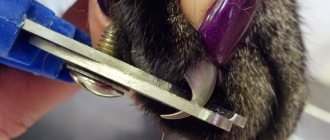Every member of the cat family has claws. They serve as protection from the dangers of the outside world. But pets do not need to regularly defend themselves, keeping enemies away. But sharp blades on the paws can cause a lot of problems for owners. Damaged furniture, wallpaper and other coverings look ugly. And when even special scratching posts do not improve the situation, owners decide to use scissors to fix the problem. It’s worth figuring out whether it’s possible to trim a cat’s claws and what to consider to make the process easier.
Why does a kitten need nails?
It’s clear why cats living outside need claws. And to escape from danger, and to feed. Why does a pet need them? He doesn't leave the apartment. And he has no idea what hunting is. Maybe you shouldn’t bother with the question of at what age can a kitten’s nails be trimmed? How about taking the baby to the veterinary clinic and getting rid of this sharp weapon?
So we get to the main idea. Claws are a cat's weapon. They are also compared to human fingers. It is the claws that help animals sense balance and play an important role in the pet’s spatial orientation. It has long been known that cats that are deprived of this important addition to their paws become “crippled.” Their musculoskeletal system is impaired.
When can you start cutting your newborn's nails for the first time?
One of the first questions that a young mother has when caring for her baby is how long after birth can she cut her newborn’s nails?
?
As soon as the baby is born, the edges of his nail plates do not separate from the skin, as they are quite soft. This is why you should not cut a newborn’s nails in the first two weeks - to avoid skin damage and, as a result, a possible inflammatory process. To prevent the child from scratching himself during this period, it is recommended to wear special mittens.
A month after birth, you can safely start cutting your baby’s nails.
Removal
At what age can a kitten's nails be trimmed? How should an adult cat cut them? Do you need to go to the clinic every time? At home, on your own? No, your hand won't rise. We'll have to carry it. And this will take time. Remove these claws once and for all. Moreover, why does the cat need them? Should I sit at home with my claws? Only the sofa spoils the wallpaper, he ignores the scratching post, he’s a bad creature. This is a bunch of questions swirling around in the owners’ heads.
The owner loves his animal and wants to do the best for everyone. It would be nice to rid the kitten of its claws, as it doesn’t seem to need them at all. And yourself - from problems with damage from these very claws. Just before taking your pet for surgery to remove them, you need to think several times. Is it worth it?
As mentioned above, in animals without claws the functioning of the musculoskeletal system is impaired. And that is not all. A cat, deprived of its main support and tool for protection, experiences extreme stress. Once outside, such an animal will die immediately. He has no chance of salvation.
Here the emphasis has been long and persistently placed on the musculoskeletal system. Someone will be surprised what claws have to do with it. The thing is that during the declawing operation, the phalanges of the cat’s fingers are cut off. Imagine that a person has been partially deprived of his toes. How will he walk after this? And now it becomes clear what it’s like for the cat.
Preparing for a haircut
An animal experiences stress when its owners start something “against” it. It’s worth starting with preparatory procedures, and preferably from infancy. Adult animals are reluctant to change. Without preparation, the cat may be injured.
The right moment is chosen for a haircut. The cat should be free from business: food or games. The animal is picked up and gently stroked, so the pet relaxes. Slowly, from stroking the back and head, the owner moves on to the cat’s paws - stroking and massaging them.
The main thing is that the cat’s attention should be scattered - it should not break out or suspect something is wrong. You need to allocate 2-3 days for preparatory procedures
When you touch their paws, you will notice the cat's irritation - they do not like their paws being touched. If you regularly repeat the procedure, the growing kitten will get used to it, the main thing is to provide an “anchor” for it in the form of a treat after the process
You need to allocate 2-3 days for preparatory procedures. When you touch their paws, you will notice the cat's irritation - they do not like their paws being touched. If you regularly repeat the procedure, the growing kitten will get used to it, the main thing is to provide an “anchor” for it in the form of a treat after the process.
After the kitten gets used to touching, the next stage begins - imitation of a haircut:
- the kitten is placed in a suitable position;
- touch the animal on different paws;
- inspect the claws and press on the pads.
After the procedure, the kitten will be grateful if his patience pays off with treats. The kitten also gets to know the nail clipper for the first time - he must understand that the tool will not harm him. When he begins to accept it calmly, you can get a haircut.
Why does a cat need claws?
When the cat was wild, they were needed so as not to remain hungry and not become the prey of a stronger animal. Then why do cats have claws now? There is no need to hunt - the food is always in the bowl, and those living at home have no purring enemies.
Progressive owners decide to take radical measures and declaw the cat. This is strictly forbidden. In almost all European countries, this operation, called onychectomy, is prohibited because it causes irreparable harm to health.
An improperly performed surgical operation can lead to:
- to gait disturbance;
- constant pain in the paws;
- development of infectious diseases.
The operation involves removing the claw and cutting off the phalanx of the finger. The healing process is very difficult and painful. Getting up on her paws is painful and she will limp or not be able to walk at all. The cat will lick the sore spots and will have to wear a special collar. An additional health risk is general anesthesia.
Typically, animals after onychectomy become irritable and capable of showing aggression. Unable to defend themselves otherwise, they may bite. The cat will not be able to jump even to the minimum height.
Tendonectomy is no less traumatic - cutting the flexor tendon, which ensures the release of the claws. A part of it is cut off, and the cat will always keep its claws retracted and will not be able to scratch or cling to anything.
The discomfort and pain that the pet experiences are a small part of the negative consequences. The joint cannot move normally, and the tendon takes a long time to heal. The cat suffers physically and is harmed to its mental health. There is a danger of infections and other complications.
Subsequently, you will still have to trim the overgrown claws, since the cat will not be able to do this on its own. So isn’t it better to do this regularly, without causing unnecessary pain to your beloved pet?
Alternative to home nail trimming
We found out how to trim a cat's claws at home. But, unfortunately, not every owner can handle such an easy task if:
- The cat does not allow haircuts;
- The claws are black, so the pulp is not visible;
- After the procedure, the pet cannot recover for a long time, experiencing stress.
What to do if the owner with a nail clipper in his hands has failed, and the clawed pet is hiding under the bed? In some cases, you can do without a haircut. Let's consider methods of grinding and trimming nails that are alternative to home manipulations:
- Using a scratching post.
Sometimes owners try to help homebody cats by purchasing a scratching post. But not all pets like to use it, preferring the owner’s sofa as an object for sharpening. However, if you teach your cat to wear down its claws from a young age, then there shouldn’t be any problems. The simplest scratching post can be purchased at a price of 300 rubles;
Add to cart
Quick view
Compare
Close
Impregnated carpet scratching post
300,00 ₽
- Visit to the groomer.
In some cases, it is easier to pay a professional than to persuade an obstinate pet to remove its claws with scissors or a nail clipper. In the capital's salons, they ask for a service from 300-500 rubles, in Russia the prices are lower - from 150 rubles. The cost of trimming doubles if the cat is acting hostile. By the way, if the owner orders a range of services (bathing, haircut, combing), then in some salons the nails can be trimmed for free; - Buying anti-scratch caps.
Those owners who doubt whether they need to trim their cat’s claws should think about special silicone attachments. They are attached to the claw with glue (comes with anti-scratch pads) and last for at least a month. The following products are selected based on the size of the pet: XS – for animals weighing less than 2.5 kg; S – for miniature individuals weighing up to 4 kg; M – for medium cats weighing up to 6 kg; L – for healthy cats like Maine Coons. The cost of a package of anti-scratch pads (20 pieces plus a tube of glue) starts from 200 rubles. If the procedure for gluing the caps is done by a groomer, you will need to pay another 500-800 rubles;
New
Add to cart
Quick view
Compare
Close
ANTI-SCRATCH nail caps for cats, red
200,00 ₽
New
Add to cart
Quick view
Compare
Close
ANTI-SCRATCH nail caps for cats, purple
200,00 ₽
- Onychectomy.
The worst solution is to deprive the cat of its claws. However, such operations are carried out in veterinary clinics. If the owner is still interested in the question of how much it costs to declaw a cat, then the amount can reach up to 5,000 rubles. But such a surgical intervention has a lot of disadvantages:- To remove the claw phalanx, anesthesia is administered (which is very unsafe for health);
- At home you will need to treat the seams on the paws (you can easily get infected);
- The cat will have to wear a special collar for a week (or more) to avoid damaging the stitches;
- After surgery, the animal may have problems coordinating movements;
- An “unarmed” cat experiences severe stress: it becomes withdrawn, apathetic, and sometimes aggressive;
- Finally, it is simply inhumane, as if the phalanges of all 20 fingers were amputated at the same time.
We borrowed the material from the wonderful website of our partners DOGCATFAN.COM
If you find an error, please select a piece of text and press Ctrl+Enter.
Use of materials on other resources is possible only with the written consent of the editors and co-authors of the articles
Nail trimming and breed
At what age can you cut the nails of a Scottish, Siamese or Persian kitten? In fact, nothing depends on the breed here. It all depends on the age of the animal. Claws are formed in felines by the age of 4-6 months. It is during this period of time that owners begin to prune them.
Do I need to take my pet to the veterinary clinic for this? If the owner is very afraid to perform the procedure on his own, then it is possible. But there is nothing complicated about this manipulation. Below we will tell you in detail how to trim your pet's claws.
Popular cat haircuts
There are exhibition and home haircuts.
The following hairstyles are ideal for home use:
- lion - all hair is cut off except the head, the tip of the tail and the paws below the “knees” and “elbow”;
- puss in boots - in this case, hair is left on the head, tail and the entire surface of the limbs;
- summer
Exhibition or model hairstyles are created by experienced groomers.
There are many options for “laying”:
- continental,
- puma,
- harlequin,
- modern,
- the Dragon.
If your plans do not include a cat grooming or the animal stubbornly does not give in to the hairdresser’s onslaught, then you will have to monitor and care for the fur as usual:
- periodic combing;
- timely removal of matted hairs;
- the use of shampoos and conditioners that help soften and straighten the hairs.
Long-haired breeds must be given special products that dissolve mats in the stomach, or use ready-made food that already contains the necessary absorbable ingredients. And to prevent heat stroke, you will have to get an air conditioner.
Well, a video on the topic of how cats are cut in salons:
How to trim claws correctly?
It is important to learn how to trim your furry pet's nails correctly. Inept actions can lead to serious injury and severe stress for the animal. If there are significant doubts about the correctness of your actions or fear of manipulation, it is recommended to entrust the first haircut to a professional, so that, after observing the process, you can subsequently repeat it at home without any fears.
With or without claws?
Is it possible to do something with the cat to prevent it from scratching? Veterinarians know 8 or 9 ways to deprive her of this opportunity. But after the most “humane” of them, the animal will feel like a child playing with tightly bandaged hands or walking in a straitjacket.
Impacts of “moderate severity” will cause sensations in the animal approximately the same as filling a carious tooth without painkillers in a person, and they will have to be used regularly: cat’s claws are constantly growing. And “radical” methods generally smack of fanaticism and leave the animal disabled.
Haircut procedure
How to trim your little friend's nails? This is the most important question owners ask. And no wonder, a person is afraid of hurting his animal. Particularly fearful people go to a veterinary clinic and entrust the procedure to specialists. And for those who decide to cut their nails on their own, detailed instructions are provided on how to do this.
At what age can a British kitten's nails be trimmed? As mentioned above, breed does not matter. Only sphinxes begin to cut their claws earlier than others because of their skin characteristics.
But let's move on to the most basic thing - the haircut procedure. What you need to know about it:
- The necessary tool is special nail clippers for cats. Sold in pet stores. Or you can get by with simple nail scissors, nippers or tweezers. Nail scissors have been tested by the personal experience of many owners.
- Before starting the procedure, the instrument must be disinfected. Wipe with alcohol, for example.
- Pick up the kitten. Sit with him on a chair or in an armchair near the window. To see the blood vessel in the nail without damaging it, you need good lighting.
- We sit the kitten facing us.
- Nail trimming begins with the front paws. The paw is taken between the fingers and lightly pressed on it so that the animal releases its claws. The claw is lifted with a tool and only the light base is cut off without affecting the blood vessel.
- After the claws on the front paws are trimmed, we proceed to the hind paws.
- At the end of the procedure, you can praise the kitten and give something tasty.
As you can see, the procedure for trimming nails is not as complicated and scary as it seems at first. By the way, let us remind you at what age you can cut a kitten’s claws. From 4-6 months.
How to trim a cat's or dog's claws correctly?
First, the animal needs to be petted
,
calm down
, if it’s a cat, sit it on your lap, with its back to you.
Take the paw
in your hands,
press gently into the center of the pad
so that
the claw opens
.
Look at the claw and you will see a free edge
that can be trimmed and then pink tissue inside the claw - these are
nerve endings and blood vessels
that you do not want to damage.
Trim the free edge of the claw, leaving two to three millimeters to the pink tissue
.
Do not forget that there is an additional claw on the front paws; it is very important to trim it, as it does not grind down at all and can grow into the pad. If suddenly you trim a nail more than necessary and it begins to bleed, do not be alarmed.
Using a cotton swab, cauterize the vessel with potassium permanganate, it is sealed and the bleeding stops very quickly
If suddenly you cut a claw
more than necessary, and it
began to bleed
, don’t be alarmed.
Using a cotton swab, cauterize the vessel with potassium permanganate
, it seals and the bleeding stops very quickly.
Dog nail trimming
The technique is no different from trimming cats' claws. If the animal is large, you may need someone's help.
Many dogs have transparent claws
, so
the blood vessel is clearly visible
.
If your dog's nails are dark in color, it will be difficult to locate the vessel. Take your time, cut off 1-2 millimeters from each claw
. At the same time, the dog may flinch, not because it is in pain, but rather because it is frightened by sudden movements.
If the animal is nervous, you can release it and then continue the procedure
The nails on the hind feet are shorter, so they can be trimmed less frequently and more carefully.
Nail trimming
– this is a reason to examine your pet’s paws for damage and fungal diseases.
Don’t forget to pet the animal after the procedure and treat it to something tasty. This way the animal will quickly get used to it and will take nail trimming calmly. Using these tips, you can try to trim your pet’s nails yourself, but if you are not sure that everything will work out, our specialists will be happy to help you carry out the procedure quickly and painlessly and show you how it’s done.
Benefits of claw trimming
The question of whether a cat’s claws need to be trimmed is a top priority for owners, and many decide positively. Compared to removal, this method is still much more humane, and the cost of declawing a cat is quite high. Firstly, pets cannot grind their claws down to the desired size on their own; they grow too long and can peel off, become ingrown and injure their paw pads. In addition, cats have a so-called fifth claw located on the back of their front paws. This nail always grows freely, without participating in the cat’s scratching, and therefore she does not have the opportunity to sharpen it.
If you do not take care of the animal's claws and do not trim them if necessary, the fifth claw can begin to grow in and cut quite painfully into the pads of the paws.
There is no need to cut it too often; it is enough to do it during the main procedure.
Secondly, we cannot ignore the everyday side of the issue. Almost all owners of domestic cats have had to live in an apartment with peeled wallpaper and sofa upholstery, scratched furniture and flooring.
Thirdly, the question of whether it is possible to cut the nails of cats is always answered in the affirmative by owners of purebred animals - such a haircut is a necessary procedure before exhibitions. Pedigree kittens often have their claws trimmed in the first week after birth.
Finally, this procedure is simply necessary if there are children in the house - whether cats can have their claws trimmed varies from owner to owner, but the child must be completely protected from possible injuries. Or, instead of cutting the claws, you can try putting special caps on the cat.
How can you trim your pet's nails?
Pros often emphasize that ordinary scissors or clippers from a manicure set are not suitable. They are a little disingenuous; if used carefully, these devices will not cause any harm. And not everyone has special nail clippers and trimmers.
The most commonly used devices are:
- A nail cutter is a special scissors for trimming a cat’s claws, made of hard stainless steel.
The guillotine trimmer is suitable for beginners. After pressing the handle, the blade extends, quickly removing the desired section. A sickle-shaped device with a sharp arc is also good.
Nail clippers are also convenient for this type of work. But they need to be held perpendicular to the claw. If you “tilt” them at a large angle, the nail plate may delaminate, and such injuries are useless.
Use a nail file or a small block to correct the shape. These devices must be tough - animals have much stronger claws than ours.
As you can see, the devices are simple. Before the procedure, the instrument must be disinfected by wiping it with a solution or alcohol. It wouldn't hurt to stock up on hydrogen peroxide and cotton pads either.
Did you know? Among the staff of the British Prime Minister's residence on Downing Street, there was also a place for cats. The first title of the country's chief mouser was given to a purr named Veksel in 1924. Now Larry holds this post (this is his second “cadence”).
At what age can you start?
If the breeder has never trimmed the puppy’s nails, then try to accustom the baby to cutting his nails literally from the first days of his stay in your home.
If you have acquired a 2-month-old baby, then it is quite possible to accustom him to this procedure . After all, the sooner you start, the easier it will be for you in the future, since the pet will not be afraid and nervous.
Expert opinion
Kozhevin Semyon Kirillovich
Expert dog handler.
“Experienced breeders try to start trimming puppies’ nails as early as possible, from about 1.5 to 2 weeks of age. This is necessary so that the baby does not scratch the mother’s mammary glands and she does not refuse to feed. Sometimes, such a haircut is a matter of survival of the whole litter. And since puppies’ nails grow quickly, they are trimmed at least once every 2 weeks. For an adult dachshund, one haircut per month will be enough.”
How to trim a kitten's claws - nail clippers and improvised tools?
Let's say you have an urgent need to give your pet a manicure. How to trim nails yourself without harming your pet? If you have a nail clipper, the task becomes easier. If the kitten is about to have its nails trimmed for the first time, and you don’t have the tools, you can use improvised media while observing safety precautions.
Important! Don't set yourself the task of trimming all of your kitten's nails at once. If you were able to cut one claw in one approach, this is already a success.
Regular scissors
The first thing that comes to the mind of an inexperienced owner is to trim the pet’s claws with ordinary scissors, but is this possible? Hypothetically, you can...if:
- The cat will not twitch.
- You have a steady hand.
- The cat has thin claws.
- You only need to trim the ends.
What could go wrong? The structure of a cat's claws is significantly different from that of a human. When using regular scissors to trim nails, there is a very high probability of:
- Crushing a claw is very painful.
- Injuring your finger if the cat pulls its paw is even more painful.
Have you injured your pet unknowingly? In such a situation, it is extremely important to quickly stop the bleeding and ensure that the wound does not become infected. The injured claw will grow back, after which it needs to be trimmed. If the wound looks serious or your finger is injured, it is best to consult a doctor. If you don’t have nail clippers at hand, and your claws urgently need to be shortened, it’s wiser to use a nail file or nail scissors.
Nail scissors
A small kitten (1-3 months old) can have its nails trimmed with nail scissors. The only nuance is the model of the scissors. Nail scissors can be distinguished by their tips:
- Curved - for cuticles.
- Direct.
- Rounded – safe for cutting off hangnails and corners of nails.
Nail scissors with rounded tips are suitable if the nails need to be blunted rather than trimmed. Simply put, if you only need to cut off the ends so that the baby does not cling to the bedding and injure himself, you can hold off on buying nail clippers.
Can nail clippers be used to trim nails?
Nail clippers (for humans) are one of the most common tools used by inexperienced owners to injure cats. To painlessly shorten your pet's claw, you need to cut it at an angle. The blades of the tweezers close straight, but in order to set them at the desired angle, the cat's paw will have to be bent at an unnatural angle.
Again, if your pet has an exceptionally calm temperament and lies motionless in any position during the procedure, tweezers are suitable. If the pet jerks its paw when the claw is caught between the blades, it will be injured. By the way, if you use tweezers, even veterinary ones, the pressure on the handles should be firm and sharp. By cutting the claw slowly and smoothly, you risk crushing it.
How to use a guillotine correctly
Have you bought nail clippers and don’t know how to use them? The good news is that the guillotine is easy to use and the procedure is safe. The second news is that you probably won’t be able to trim all the claws the first time.
First, check your pet's reaction by touching the guillotine to the claw. Click the claw clipper and watch the reaction again. If the cat does not pull back its paw, you can try cutting it. Be sure to hold your pet's paw with your free hand. Cut off only the tip (sharper) of the claw. Your movements should be confident and firm. The guillotine cuts the claw at an angle, so the pet should not experience any discomfort.
What to do if damaged?
If, however, damage occurs to the animal while trimming its nails, stop immediately and begin treating the injury or wound. To begin, prepare some cotton pads and anti-bleeding agents so you have everything at hand. If the injury is more serious than you thought, try to stop the bleeding and go to the vet. He will tell you what to do and what to do next.
Once you've finished trimming his nails, treat your friend to his favorite treat.
Advice: do not force the animal to cut its nails and do not mock it while trimming its claws, because this way it will avoid not only this procedure, but possibly you as well.
But if you still do not plan to do the first procedure on your own, carry out this haircut under the supervision of a veterinarian. A certified specialist will tell you how to handle the tool and the animal, and tell you how to avoid injuries. He will also give advice on how to make the procedure less stressful for all participants in the process.
When should a kitten's nails be trimmed?
The first time the claws are trimmed is when the kitten is one month old. It is advisable that at this time he is tired and sleepy.
During the procedure, you should not play with it: it will only interfere. You should not frighten the animal, use force, or beat it. This will cause psychological trauma to the pet. In the future, the cat will be afraid of trimming.
For kittens, use guillotine cutters. The procedure must be carried out with caution, cutting off only the very tip.
How to prepare a cat for the first procedure?
You should not trim the claws if your dog is too active and excited, as he may mistake it for violent actions, which will scare him away more. Therefore, choose a time when the kitten is calm, or better yet, when he is very tired. This way he won’t try to escape and won’t get too stressed. Remember the following rule: do not make slow movements when trimming nails, as this may begin to irritate the animal. It will begin to get nervous and break out of the owner’s hands, which will subsequently lead to damage or even injury.
Pet your pet, give him his favorite delicacy. By appeasing your pet, it will be easier for him to make contact with you, and he will be less aggressive before starting the procedure.
And most importantly, you need to talk to the animal. After all, he is also a living creature and loves when the owner speaks to him kindly.
Advice! Remember, the calmer the owner, the more obedient the animal.
So prepare yourself in advance, calm down and tune in, because an animal, even a small one, understands the feelings of its owner.
If the animal still breaks out and becomes nervous, do not yell at it. This will make him even more nervous, which will frighten the animal in the future during the next haircut.
You might think your friend is in pain during the procedure. But if you do everything correctly and at the same time without sudden or too slow movements, then your pet will be satisfied.
What is required for a haircut at home?
A set of necessary tools:
- Hemostatic agent. This could be flour, baby powder, or hydrogen peroxide in case you hit a live part of the nail and your dog bleeds.
- A nail file is needed to remove irregularities, sharp corners and nicks after cutting.
- It is better to purchase a special nail clipper at a pet store or grooming salon.
- Cotton pads.
- Pet treat. Be sure to reward him if he behaved well during the procedure.
IMPORTANT!
Under no circumstances cut your dog’s nails with regular scissors, otherwise you will not only injure him, but also scare him.
Then cutting will become a real problem.
Tools and items
To care for your pet's paws, you will need several tools.
Basic set
Claw cutter
The most important of them is nail cutters (tongs). It comes in different sizes and there is an opportunity to choose “your own” tool for any dog. The price range is quite wide: the minimum cost for a nail clipper starts from 100 rubles and can reach almost 500-600 rubles. On average, the instrument is sold for 200-300 rubles.
Another type of claw cutter is the guillotine.
Another model of nail cutter is the guillotine forceps. The guillotine model has only one blade, which appears in the hole when the handle is pressed. More suitable for small and toy breeds with thin nails.
Claw clipper guillotine
The guillotine nail cutter has a significant drawback: it is too noisy and can frighten less stress-resistant dogs. And if the dog gets nervous, then it will be extremely difficult to insert the claw into the special hole. This model sells for 400-600 rubles.
A similar nail cutter, the guillotine, is also used to trim cat claws.
File
Special file for sharpening claws There are special files for pets. Trimming may leave sharp scars on the nails. To prevent scars from causing torn furniture, and to prevent your pet from experiencing severe discomfort and even pain, the claws are carefully filed after the procedure.
It is not advisable to replace a file with a “human” one - people’s nails are much thinner than those of dogs and such a thin tool simply will not give the expected effect. The average price of a file is 100-500 rubles, depending on the manufacturer.
Trimmer
Battery-powered trimmer (grinder) Master groomers actively use trimmers (grinders). This is an analogue of a regular file, powered by batteries. The trimmer is a “wheel” with sandpaper that spins and thereby quickly grinds down the claw. The tool does its job much faster than a file. Some owners completely replace nail trimming with trimming using a trimmer.
What will be required additionally
Stocking up with just a nail clipper and file is not enough. You must have cotton pads, an antiseptic or a hemostatic agent with you. Chlorhexidine or talc, a hemostatic powder, will help treat the wound quickly and effectively. There is always a chance of damaging the pulp, and if this happens, you need to stop the bleeding immediately.
Will other scissors work?
It is a mistake to think that simple or manicure scissors will be an excellent replacement for a nail clipper.
- Manicure models are too small even for toy breeds.
- Standard scissors simply won't cut a dog's nail.
Even if you make every effort, you will not get the desired result. And, rather, on the contrary, this can only damage your pet’s finger.
What is a mat cutter for dogs?
What to do when the animal is not given?
Pets have different temperaments. There are aggressive and nervous cats. They are unlikely to allow their nails to be trimmed in peace. Most likely, the animal will scratch, bite, and break out.
If the cat does not give in, you cannot show force: this can injure its paws. It is advisable to perform the procedure by two people: one holds, the other trims the claws. You can also swaddle your pet or wrap it in a blanket.
If he is very nervous, it is better to refuse the event and do it when the animal is more pliable and balanced.
How often should the procedure be performed?
The frequency of nail trimming depends on the conditions in which the dog lives. If your pet lives in the city and walks along the asphalt sidewalk every day, then you will trim its nails less often.
If you live outside the city, you will have to do this more often..
After all, when walking on a soft earthen surface, the claws do not wear down and can grow to serious sizes, and this is fraught with consequences.
Generally speaking, an adult dachshund's nails should be trimmed once every 3-4 weeks..
How can you tell when it's time for a haircut? By the characteristic sound of claws on the floor. As soon as you hear a clattering noise, you know it’s time to trim your nails.
How to train an adult cat to use a scratching post?
The situation is a little more complicated if the owner is faced with the problem of how to accustom an adult cat to a scratching post.
After all, you will have to somehow explain to the animal that you can no longer scratch the furniture or carpet, and draw its attention to a new unfamiliar object. To do this you need to arm yourself with perseverance and cunning. What should you pay attention to when choosing a scratching post?
What should you pay attention to when choosing a scratching post?
The first step is to choose the right drape so that your pet likes it. Several important details will help the owner choose the appropriate option:
- a cat’s favorite way to sharpen its claws (this can be one corner, a horizontal or vertical surface). Accordingly, the pet store selects a scratching post in the form of a column, rug or corner.
- stability of the drape - the ideal option would be a model with a heavy and wide base. After all, if she fidgets or suddenly falls under the weight of the cat, the animal will get scared, and this is unlikely to help in the question of how to accustom an adult cat to a scratching post.
Designs for sharpening cat claws are very diverse; a play complex with various platforms, shelves, tunnels and hanging toys would be an excellent choice. A scratching post with several tiers will be a favorite place for a cat, because here she will sleep, climbing higher, play and sharpen her claws. True, such a drape is not very cheap, but it will help keep your home interior intact and save money on buying new furniture.
Where to place the scratching post?
Initially, the most correct location for the claw grinder will be exactly the place that the cat has already liked to sharpen its claws. At first, the sofa or corner of the wall must be covered with something, or, if possible, the animal’s access to these places must be completely limited.
Draw your pet's attention in every possible way to such a new piece of furniture as a scratching post. How to train a cat to scratch it? First, call your pet to the drape or lure it with a game. Place the paws on the surface and gently press them so that the cat extends its claws into the upholstery material
Talk to her kindly, praise her, give her her favorite treat. The animal is unlikely to understand what’s what the first time, be patient and repeat this procedure several times a day. Every time your pet tries to scratch in the wrong place, pick him up and take him to the scratching post. Move the cat's paws along the drape again, tease with the toy to provoke it to release its claws into the upholstery. And reward the animal every time for the correct reaction.
Place the paws on the surface and gently press them so that the cat extends its claws into the upholstery material. Talk to her kindly, praise her, give her her favorite treat. The animal is unlikely to understand what’s what the first time, be patient and repeat this procedure several times a day. Every time your pet tries to scratch in the wrong place, pick him up and take him to the scratching post. Move the cat's paws along the drape again, tease with the toy to provoke it to release its claws into the upholstery. And reward the animal every time for the correct reaction.
Over time, when the problem of how to train a cat to sharpen its claws on a scratching post has been solved, and the correct habit has been developed, gradually move the drape to the place that you have previously thought up for it.
Top Articles: What is the difference between a crocodile and an alligator?
If the house where the cat lives is quite large, then it is better to get several scratching posts and place them in different places. One of them should definitely be placed near the place where the pet sleeps or spends the most time.
How else to attract a cat's attention to the drapery?
If you still cannot cope with the dilemma of how to accustom your cat to a scratching post, try treating the catnip with catnip (catnip). Cats really like the smell of this plant - it is sold in pet stores, both in dry form and in sprays, and is used to attract animals. And the sharp smell of citrus fruits will help scare your pet away from the sofa or wallpaper. A few drops of lemon juice applied to favorite places to sharpen claws will keep your pet away from there for a long time.
The main thing in this matter is persistence and consistency, do not expect success the first time. Remember, you can achieve the desired result with a little patience and affection.
When is the best time to cut a baby's nails?
For a newborn, such a process is new and unusual. In order to leave only good impressions about this in the subconscious, it is important to cut nails only when the child is in a calm state
.
The best time to do this:
- after satisfying the child’s physiological needs: feeding and changing diapers, when the baby is not suffering from colic, nothing bothers him, he is in a good mood, full and happy with what is happening around him. In the process of treating nails, you should smile at the baby, talk to him, sing affectionate songs, create an atmosphere of kindness, calmness and comfort;
- during bathing, the nail plates become softer and more amenable to treatment, so after taking a bath it’s time to do this procedure;
- if your child is quite active when awake, then you can carry out this procedure while sleeping, but you should be doubly careful not to injure the child. After all, if this happens, then this factor may negatively affect the baby’s psyche and there may be problems with falling asleep.











